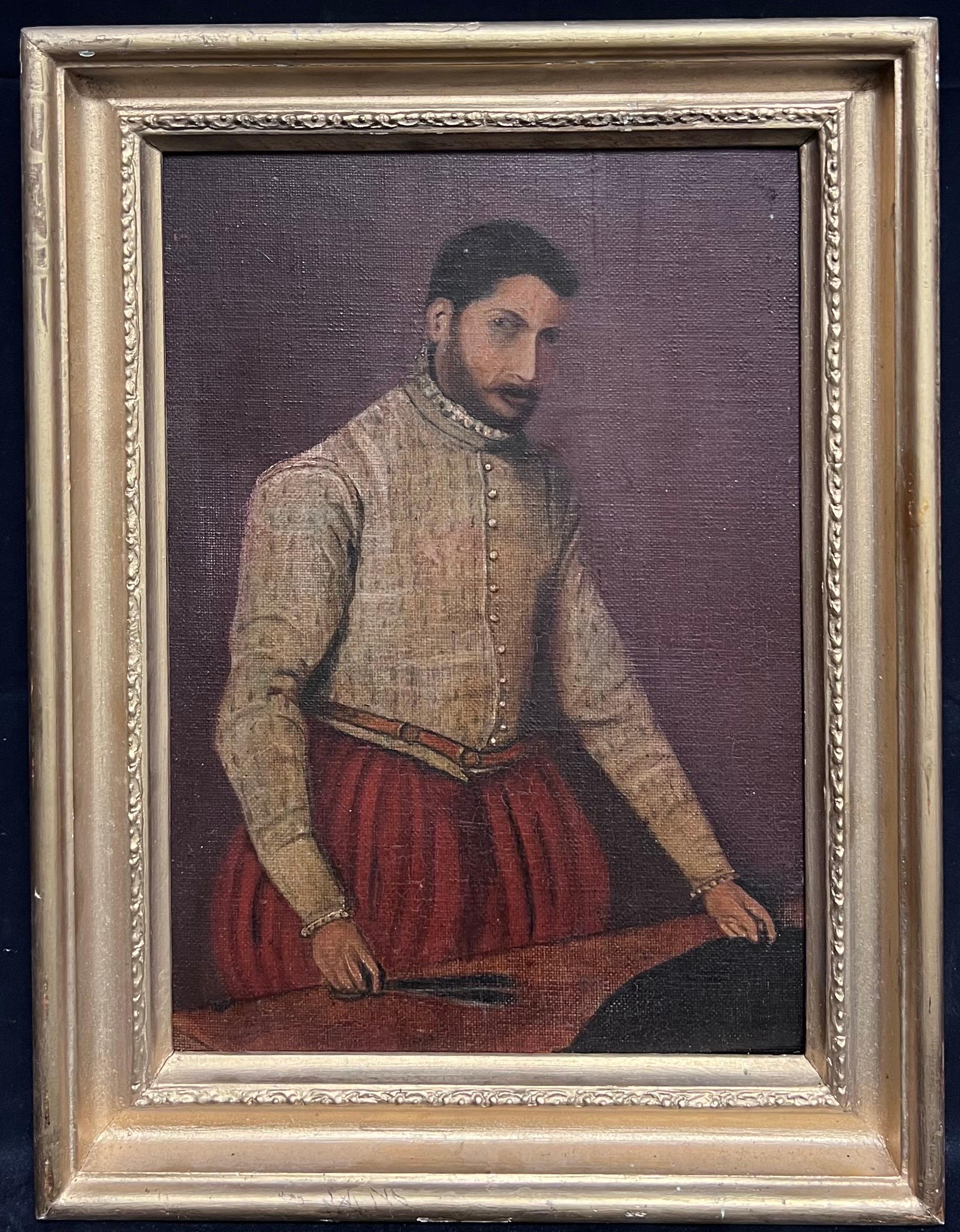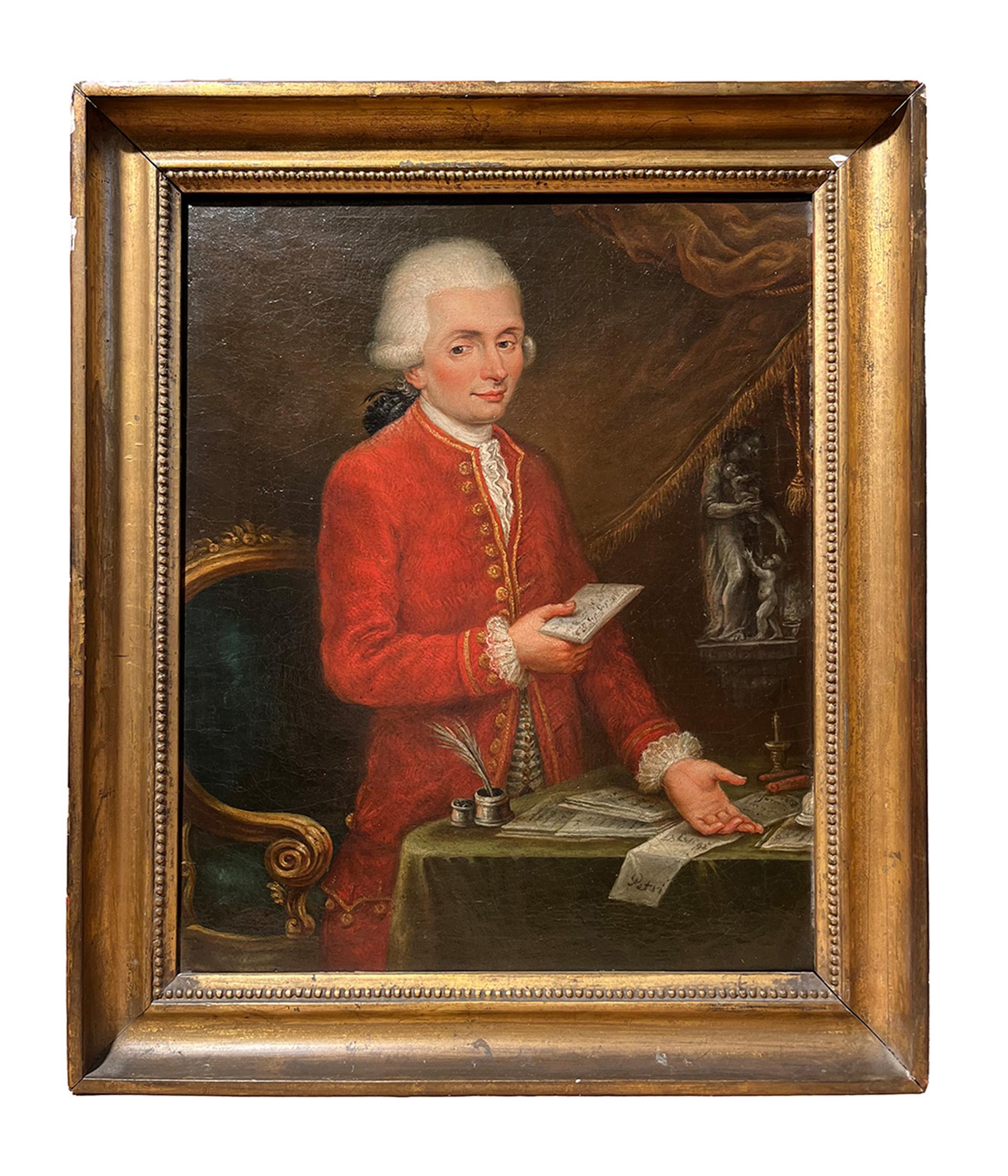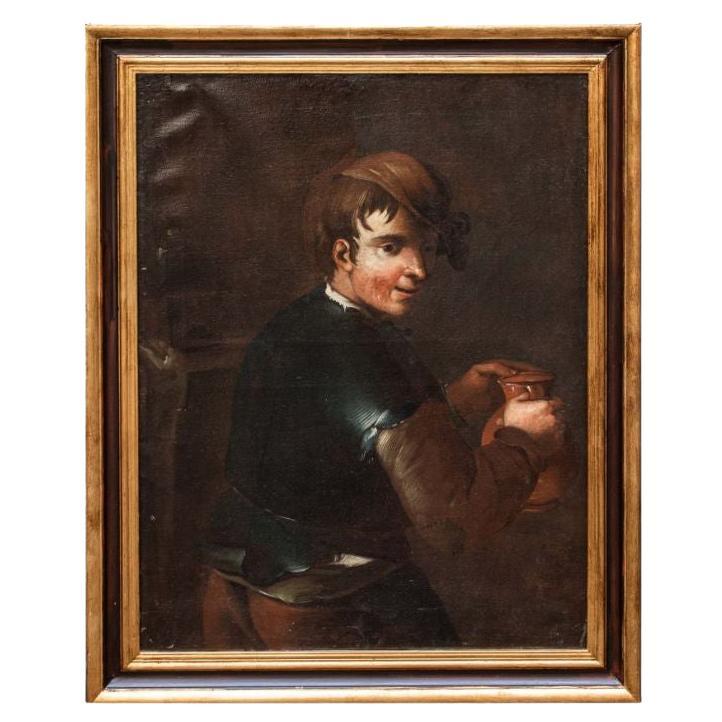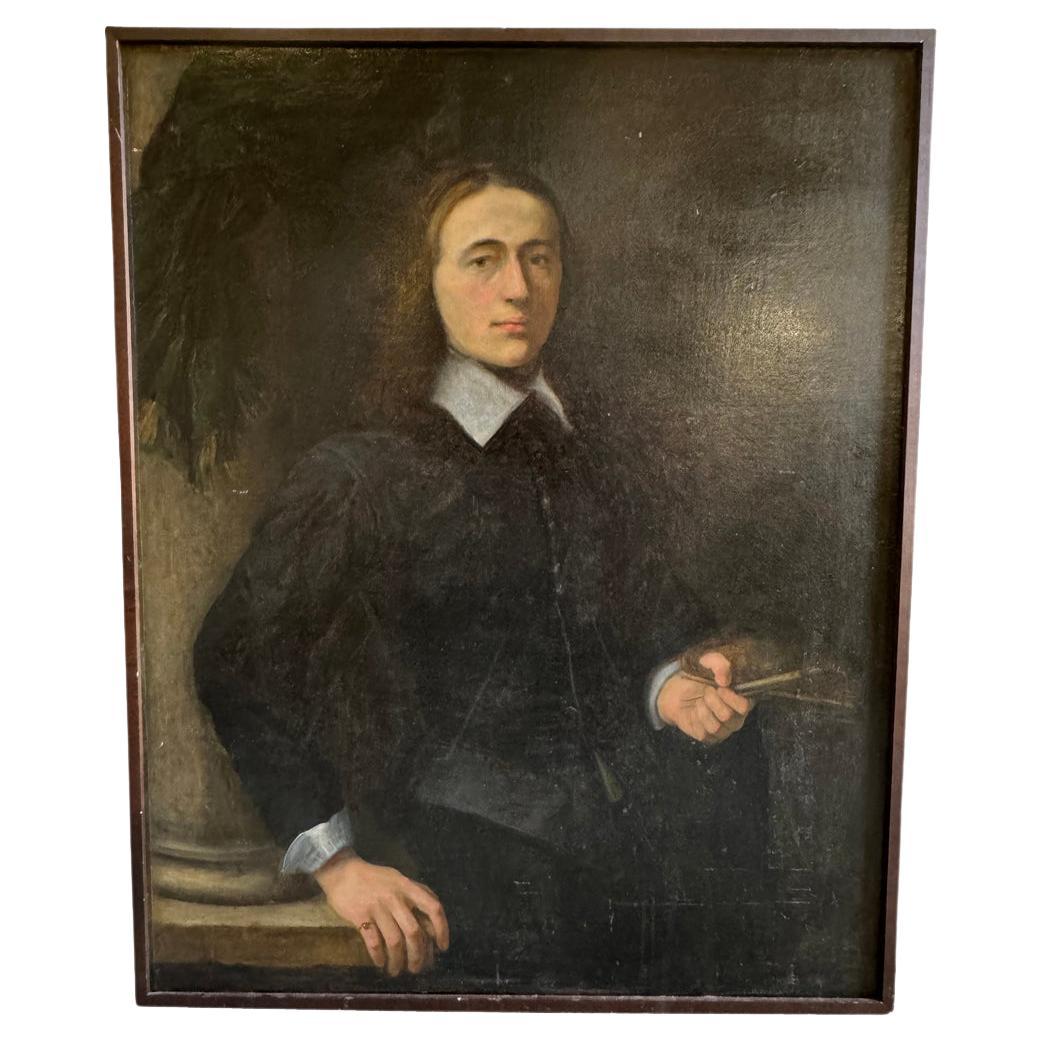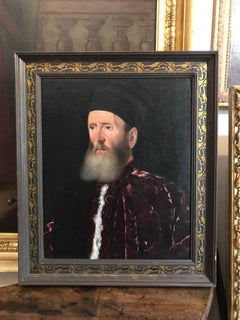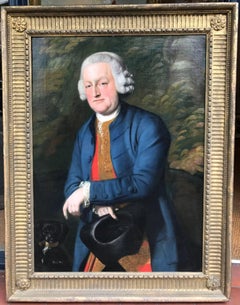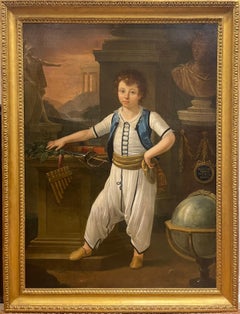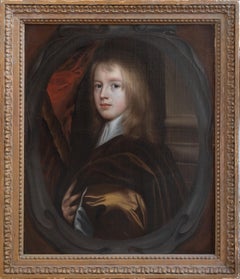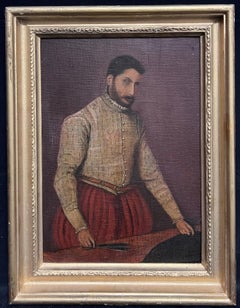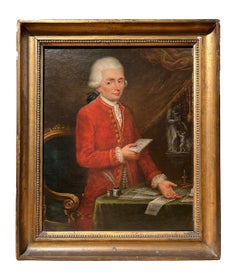Items Similar to 17th Century Italian Oil Painting Portrait of Music Prodigy Girolamo Frescobaldi
Want more images or videos?
Request additional images or videos from the seller
1 of 10
Antiveduta della Grammatica17th Century Italian Oil Painting Portrait of Music Prodigy Girolamo Frescobaldicirca 1605
circa 1605
$57,637.04
£42,000
€49,383.19
CA$79,580.91
A$88,249.34
CHF 46,368.48
MX$1,078,256.97
NOK 580,132.97
SEK 544,553.91
DKK 368,655.17
About the Item
Portrait of Girolamo Frescobaldi (1583-1643)
Attributed to Antiveduto Della Grammatica (1571-1626)
Oil on Canvas
1605-1609
Framed in a Nineteenth Century gild and composite frame
44.5 x 41 inches framed
Provenance:
Baron Kettleby and by descent to
The Reverend W.A. Bedbrough of Tunbridge Wells by 1909
Antiveduto della Grammatica (1571-1626)
Antiveduto Grammatica (1571 – April 1626) was a proto-Baroque Italian painter, active near Rome.
Grammatica was born in either Siena or Rome. According to Giovanni Baglione the artist was given the name Antiveduto ("foreseen") because his father had a premonition that he would soon be born during a journey between his native Siena and Rome. It was in Rome that Antiveduto was baptised, raised and based his career. His apprenticeship with the Perugian artist Giovanni Domenico Angelini (Giandomenico Perugino) introduced him to small-scale work, mostly on copper. He gained the nickname "gran Capocciante" because he specialised in painting heads of famous men. A decade later, in 1591, Antiveduto set up as an independent artist.
Grammatica's earliest surviving public commission, an old-fashioned configuration depicting Christ the Saviour with St. Stanislaus of Krakow, St. Adalbert of Prague and St Hyacinth Odrowaz, was painted for the high altar of San Stanislao dei Polacchi. Characterized by Giulio Mancini as most zealous in his profession, Antiveduto began his association with the Accademia di San Luca in 1593. He gained great familiarity with the two protectors of the Academy, Cardinals Federico Borromeo and Francesco Maria Del Monte, and was closely attached to the latter; so much that he was elected to the highest office of the association as "principe" in 1624. Shortly after this, however, he became embroiled in scandal. The machinations of Grammatica’s enemy Tommaso Salini over the attempt to sell off the Accademia's altarpiece, thought to be by Raphael, brought about a humiliating retreat, when Cardinal Del Monte intervened to re-establish the constitution of the institution. His fortunes were in a way linked with the Cardinal himself, who was much frowned upon by the Barberini, and his death preceded that of Del Monte by four months, in April 1626.
His works are exhibited in numerous public collections, including the State Hermitage Museum - St Petersburg, the Museo Nacional del Prado – Madrid, the Kunsthistorisches Museum, Vienna, the Muzeul Naţional Brukenthal - Sibiu/Hermannstadt, Romania, the Kelvingrove Art Gallery and Museum – Glasgow, and the Maison D’Art Gallery, Monaco.
Sitter
Girolamo Frescobaldi (1583-1643) was one of the most important composers of keyboard music in the late Renaissance and early Baroque periods. A child prodigy, Frescobaldi studied under Luzzasco Luzzaschi in Ferrara, but was influenced by a large number of composers, including Ascanio Mayone, Giovanni Maria Trabaci, and Claudio Merulo. Frescobaldi was appointed organist of St Peter’s Basilica, a focal point of power for the Capella Giulia from 1608-1628 and again from 1634 until his death.
Born in Ferrara, his father Filippo was a man of property, possibly an organist, since both Girolamo and his half-brother Cesare became organists. Contemporary accounts describe Girolamo as a gifted composer and performer child prodigy who was brought through various principle cities of Italy. He quickly gained patronage of important noblemen.
In his early twenties Frescobaldi left his native Ferrara for Rome in 1604-7 to take up a position as the organist at Santa Maria in Trastevere. He was also employed by Guido Bentivoglio, the Archbishop of Rhodes and accompanied him on a trip to Flanders where Bentivoglio had been made nuncio to the court. It was Frescobaldi’s only trip outside Italy but the court at Brussels was musically among the most important in Europe at the time. During this trip, Frescobaldi also visited Antwerp, where local musicians were so impressed with his music, they persuaded him to publish at least some of it.
Whilst abroad, Frescobaldi was elected in 1608 to succeed Ercole Pasquini as organist of St Peter’s Basilica in Rome, though he delayed is return until 29th October in order to publish another collection of music, the keyboard Fantasie. He took up this position of grandeur on 31st October 1608 and held it until death. He remained in Rome but became estranged from his patron Bentivoglio after having an affair with a young woman and a scandal between Bentivoglio and the Medici family.
Frescobaldi also worked for Cardinal Pietro Aldobrandini between 1610-13.
Frescobaldi married Orsola Travaglini in 1613 and had five children. In October 1614 he was approached by an agent of the Duke of Mantua, Ferdinando I Gonzaga. He visited Mantua shortly after but was given such a cold reception, he fled immediately back to Rome where he continued publishing.
In 1628, St Peter’s Basilica granted Frescobaldi permission to move to Florence, under the service of the Grand Duke of Tuscany, a Medici. During his time there, Frescobaldi was the highest paid musician. In 1634 he was summoned to the service of the Barberini family, and to Pope Urban VIII, the highest prize offered to any musician.
Frescobaldi's dress is very similar to that of the Archduke Albert VII's and the Lute Player's in Grammatica's portraits. Frescobaldi was recorded as visiting the Royal Court in Flanders to Archduke Albert VII whilst accompanying his employer Bentivoglio who had been made nuncio to the court.
About the Seller
5.0
Vetted Professional Seller
Every seller passes strict standards for authenticity and reliability
Established in 1990
1stDibs seller since 2017
42 sales on 1stDibs
Typical response time: A week
- ShippingRetrieving quote...Shipping from: London, United Kingdom
- Return Policy
Authenticity Guarantee
In the unlikely event there’s an issue with an item’s authenticity, contact us within 1 year for a full refund. DetailsMoney-Back Guarantee
If your item is not as described, is damaged in transit, or does not arrive, contact us within 7 days for a full refund. Details24-Hour Cancellation
You have a 24-hour grace period in which to reconsider your purchase, with no questions asked.Vetted Professional Sellers
Our world-class sellers must adhere to strict standards for service and quality, maintaining the integrity of our listings.Price-Match Guarantee
If you find that a seller listed the same item for a lower price elsewhere, we’ll match it.Trusted Global Delivery
Our best-in-class carrier network provides specialized shipping options worldwide, including custom delivery.More From This Seller
View All16th Century Italian Renaissance Old Master Portrait of a Procuratore
By Jacopo Bassano
Located in London, GB
Jacopo BASSANO (c. 1510-1592, Italian)
Portrait of a Procuratore
Oil on canvas
30 ¼ x 26 inches (including frame)
Provenance: Lucien Bonaparte’s Collection (as Portrait of Doge Priuli, Tiziano); Rich-mond, Virginia Museum, Portrait of Doge Lorenzo Priuli.
The painting is a portrait of a man half-length, on a black background. It is a three-quarter portrait, according to a custom very common in the genre of portraiture in sixteenth century. The man is wearing a decorated...
Category
16th Century Old Masters Portrait Paintings
Materials
Oil
$241,526 Sale Price
20% Off
Free Shipping
18th Century Oil Painting Portrait of Phillip, 6th Viscount Wenman.
By Nathaniel Dance-Holland
Located in London, GB
Sir Nathaniel Dance-Holland (1750-1811) was an English portrait painter and one of the founding members of the Royal Academy in 1768. Justly celebrated in his lifetime he won several...
Category
Late 18th Century Old Masters Portrait Paintings
Materials
Oil
A Full-Length Portrait of Nicholas I of Russia in a Classical Setting
Located in London, GB
A Full-Length Portrait of Nicholas I of Russia in a classical setting. Pietro Labruzzi (1739–1805). 1802.
Signed, located and dated lower left: ‘Pietro Labruzzi Roma Pinx Anno 1802.’
Oil on canvas.
Dimensions:
Unframed: 135.7 x 98.5 cm.; 53½ x 38¾ in.
Framed: 151.6 x 115.6 cm.; 59¾ x 45½ in.
Description:
Nicholas I (Russian: Nikolay Pavlovich) (1796-1855), Russian Emperor...
Category
Early 1800s Paintings
Materials
Canvas, Oil
17th Century Oil Painting Portrait of a Young English Boy
By Gerard Soest
Located in London, GB
Gerard SOEST (1600 - 1681)
Portrait of a Young Boy
oil on canvas
35.5 x 30.5 inches inc. frame
Gerard Soest (circa 1600 – 11 February 1681), also known as Gerald Soest, was a portra...
Category
17th Century Old Masters Portrait Paintings
Materials
Oil
Large Beautiful Early 17th Century Painting of St Peter
Located in London, GB
17th Century Italian School
St Peter
Oil on Canvas
55 1/2 x 41 inches
This large and tender rendering of Saint Peter was painted by the hand of great Italian painter of the 17th Cen...
Category
Early 17th Century Baroque Portrait Paintings
Materials
Oil
Lady Dormore - A 16th Century Portrait of a key member of Shakespeare's England
Located in London, GB
Lady Dormer, Mary Browne
c. 1592
oil on panel
35 x 29 inches, unframed;
41 x 34.75 inches, inc. frame
Inscribed 'Lady Dormore'
Mary married Henry Wriothesley, 2nd Earl of Southampton who gave birth to Henry Wriothesley, 3rd Earl of Southampton - one of the great figures in Shakespears"s circle and founder of the Virginia company, developers of Virginia USA.
Henry Wriothesley, born 6 October 1573 at Cowdray House, Sussex, was the only son of Henry Wriothesley, 2nd Earl of Southampton, by Mary Browne, the only daughter of Anthony Browne, 1st Viscount Montague, and his first wife, Jane Radcliffe.[5] He had two sisters, Jane, who died before 1573, and Mary (c. 1567 – 1607), who in June 1585 married Thomas Arundell, 1st Baron Arundell of Wardour.[6]
After his father's death, Southampton's mother married firstly, on 2 May 1595, as his second wife, Sir Thomas Heneage (d. 17 October 1595), Vice-Chamberlain of the Household, and secondly, between 5 November 1598 and 31 January 1599, Sir William Hervey. She died in November 1607.[7]
Early life
When his father died on 4 October 1581 Southampton inherited the earldom and landed income valued at £1097 6s per annum. His wardship and marriage were sold by the Queen to her kinsman, Charles, Lord Howard of Effingham, for £1000. According to Akrigg, Howard then "entered into some further agreement, of which no documentation can now be found, which transferred to Lord Burghley personally the custody and marriage of the young Earl, but left Howard holding his lands", and late in 1581 or early in 1582 Southampton, then eight years of age, came to live at Cecil House in the Strand.[8]
In October 1585, at age twelve, Southampton entered St John's College, Cambridge,[9] graduating M.A. on 6 June 1589.[10] His name was entered at the Gray's Inn legal society before he left the university, and he was admitted on 29 February 1588.[11]
On Southampton's 16th birthday, 6 October 1589, Lord Burghley noted Southampton's age in his diary, and by 1590 Burghley was negotiating with Southampton's grandfather, Anthony Browne, 1st Viscount Montague, and Southampton's mother, Mary, for a marriage between Southampton and Lord Burghley's eldest granddaughter, Elizabeth Vere, daughter of Burghley's daughter, Anne Cecil, and Edward de Vere...
Category
16th Century Old Masters Figurative Paintings
Materials
Oil
You May Also Like
Italian Renaissance Gentleman Portrait of a Tailor Antique Oil Painting
Located in Cirencester, Gloucestershire
The Tailor
Continental School, 19th century
after the earlier Renaissance work by Giovanni Battista Moroni (16th century).
oil on canvas laid over board, framed
Framed: 16 x 12 inch...
Category
19th Century Renaissance Portrait Paintings
Materials
Oil
Portrait Noble Man Ceresa Paint Oil on canvas Old master 17th Century Italy Art
Located in Riva del Garda, IT
Carlo Ceresa (San Giovanni Bianco 1609 - Bergamo 1679) attributable
Full-length portrait of Giacomo Pesenti
Oil on canvas (206 x 121 cm - in frame 212 x 133 cm.)
This fascinating portrait, portraying a full-length gentleman and datable to the 17th century, illustrates the stylistic and compositional details typical of the pictorial production of the Lombardy area, Bergamo in particular. This reference is reflected in elements such as the natural light, the sober and austere setting and, above all, the subtle psychological characterisation of the face.
We are inclined to identify the hand of portrait painter Carlo Ceresa, one of the most illustrious Bergamasque figure painters of the 17th century, capable of developing a style of intense realism and acute psychological investigation. In his works, and our portrait perfectly reflects his canons, an extraordinary naturalistic imprint, great realism and remarkable essentiality are evident.
Those traits of severity, moral rigour and austerity typical of his portraiture find a perfect balance here: never courtly or rhetorical, his portraits are profoundly linked to the concept of counter-reform. Immortalising the main personalities of the time, he established himself as a point of reference for the Bergamasque aristocracy, from the Vertova to the Pesenti to the Secco Suardo.
The subject of the portrait is Giacomo Pesenti, here immortalised life-size in a rigorous black suit, his left hand resting on a table, on which is placed the necessities for writing and a manuscript, and his right hand, with a sealed ring on his little finger, abandoned along his side while he holds his gloves.
He wears a suit of incredible rigour, dressed as befits a man of his high social standing, while the sharp light focuses on his face, with an intensity that seems to be accentuated by the reflection of the white collar, with its sharp profile.
For Ceresa, it is not the richness of the garment that gives value to the person portrayed, it is the need to give feeling and bring out the character of the person, and this he succeeds in marvellously, aided by his ability to capture the essence of the person and return it to us in painting through the face and light used as a strong expressive element.
In fact, the image highlights that 'counter-reformed' composure typical of the portraiture of painters active in this area and era, adhering to a verism...
Category
17th Century Old Masters Paintings
Materials
Oil
$12,171 Sale Price
20% Off
Portrait Paint Oil on canvas Old master 16/17th Century Italian Raffaello Art
Located in Riva del Garda, IT
Tuscan painter active towards the end of the 16th century
Portrait of Captain Niccolò Orsini (Pitigliano, 1442 - Lonigo, 1510), count of Pitigliano and Nola.
Tuscany, end of the 16th century
Oil on canvas, 64 x 47 cm., Framed 89 x 73 cm.
The portrait we present to you shows the effigy of a vigorous high-ranking male figure in armor, in the most typical Renaissance pose, half-length and taken in profile, with his face and gaze turned to the side; the serious and intense expression and the facial features evoke at first glance the portraiture of early Florentine mannerism.
He is Niccolò III Orsini (Pitigliano, 1442 - Lonigo, 1510), count of Pitigliano and Nola and son of Aldobrandino Orsini, famous leader and captain (or capitano di ventura) who lived between the fifteenth and sixteenth centuries, who served for the state Pontifical in Naples and Florence and above all for the Republic of Venice.
Portraiture with these characters, which derives from ancient coinage, was used in the sixteenth century in the sequences of Portraits of Illustrious Men, both in painting and in sculpture. The profile portrait was in fact a genre reserved, according to the Renaissance tradition, for celebrations, presenting those characteristics of imperturbability typical of the military role covered.
Our painting is a work created by an author active in Tuscany towards the end of the sixteenth century, adhering to those pictorial styles made famous by the portraitist Cristofano di Papi dell'Altissimo (1530-1605), a pupil of Bronzino and then of Pontormo, known for having created a collection of about 500 portraits of illustrious men, known as the 'Gioviana Series' (now in the Uffizi Gallery); and among these it is possible to identify one dedicated to Niccolò Orsini.
Our painting is inspired, in particular, by a print taken from the collection of prints...
Category
16th Century Old Masters Paintings
Materials
Oil
18th Century by Alessandro Longhi Portrait of a young musician Oil on canvas
Located in Milano, Lombardia
Alessandro Longhi (Venice, Italy, 1733 – 1813)
Title: Portrait of a young musician in front of his desk with a score in his hand
Medium: Oil on canvas
Dimensions: without frame 39.5 ...
Category
18th Century Old Masters Portrait Paintings
Materials
Canvas, Oil
17th - 18th Century Portrait of Guy Painting Oil on Canvas by Area of Amorosi
By Antonio Amorosi
Located in Milan, IT
Circle of Antonio Amorosi (Comunanza, 1660 - Rome, 1738)
Portrait of young people
Oil on canvas, 87 x 67 cm
The painting depicting this portrait was made by an artist activ...
Category
Antique Late 17th Century Italian Paintings
Materials
Canvas
Italian 18th Century Oil Painting
Located in Round Top, TX
A very handsome 18th century Oil Painting on canvas from Florence, Italy. A wonderful portrait of an artist holding his brushes and painter's palette in his hand. A subdued and tranq...
Category
Antique 18th Century Italian Paintings
Materials
Canvas
More Ways To Browse
17th Century Italian Painting
Italian Baroque Painting
17th Century Italian Oil Painting
17th Century Copper
Antique Copper Painting
High Altar
Music Player
Baroque Oil Painting Large
31st October
Oil Paintings Tuscany
Portrait Pope
Portrait Of Pope
17th Century Dress
17th Century Man Portrait
Portrait Of A Cardinal
Baroque Altar
Art Hyacinth
Tunbridge Wells
